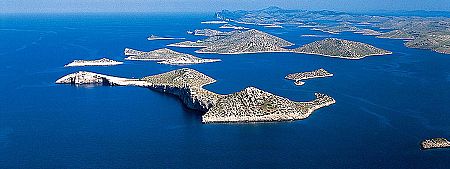Murter & Kornati
Murter

Murter is the largest settlement on the island that bears the same name and that is situated between the towns of Zadar (70 km) and Šibenik (35 km). The island is connected to the coast by a short bridge in the municipality of Tisno.
Murter is a significant tourist destination famous for its many historical sights and alluring nature, beautiful beaches, and uninhabited islands in its immediate vicinity. It is surrounded by seven hills: Crnikovac, Gradina, Raduč, Veli vrh, Malil Vršak, and Vršine. Raduč hill represents at 125 m the highest peak of the island, while Vršine hill with the church of St Roko is certainly the most visited one with a beautiful viewpoint which offers a view of the entire settlement. Gradina hill can be found at the foot of the old Roman settlement Colentum. The most beautiful beaches on Murter are located on the south side of the island. The beaches bear the following names: Kosirina, Čigrađa, Slanica, Podrvške. Beach Luke as well as the newly decorated ancient beach within the archeological site Colentum can both be found on the north side of the island. Murter is the starting point for the well-known Kornati islands. Hidden coves located in the shade of pine forests that can be reached by unexplored paths hide untold stories of curious travelers and simply call for exploration.
The Kornati islands

The Kornati islands are unique in the whole of Mediterranean. They are comprised of more than 150 islands, islets, and cliffs with a land surface which spans 69 km2. Due to its indented coastline, geomorphological features, and underwater life diversity, a part of the Kornati islands was declared a national park in 1980.
The most famous geomorphological phenomenon on the Kornati islands and their most characterizing feature are the so called “crowns” – high vertical cliffs facing the open sea. The highest “crown” (82 m) is located on the island of Klobučar, the second highest on Big Rašip (62 m), and the third highest on the island of Mana (68 m). On the northeastern slope of Kornat island, near its peak Metline, an interesting site can be found – Magazinova šrila, which the local population calls Vela ploča. Vela ploča is a bare and smooth 210 m long and 155 m wide plate which is inclined to the sea at an angle of 40°. Along the northwestern border of the national park you can find the passageway Mala Proversa. The remains of a Roman villa from the 1st century are preserved on its shores.
One of the historical sites that must be mentioned is Tureta fort which testifies to the arrival of people in this area during Illyrian times. The fort is in poor condition today, but it is one of the few preserved in this area. Beneath the Tureta fort you can find the Our Lady of Tarac Church, built in the 16th century. The church is the final destination for pilgrims who begin their journey on the first Sunday in the month of July.
One of the reasons why a part of Kornati islands has been protected and declared a national park is also its anthropogenic landscape – a rocky pasture – created by human activity (regular fire burning for pasture). The Kornati islands are a place where nature merges with man, who has been proven to live in Kornati for many thousands of years, which is reflected, among other things, in the always modest, but impressive monuments (drywalls, olive groves, piers, forts, fortresses, churches, salt pans, etc.), that are an additional and certainly valuable decoration of the Kornati National Park.
The rather large distance from the coast, the biological abundance of the underwater world, pirate attacks, good pastures, restless land areas, good shelters during bad weather at sea… - these are all reasons why Kornati have always been at the same time both a hospitable and inhospitable area throughout human history. Kornati have always been on the edge of habitation and uninhabitedness, peace and turmoil, wealth and poverty, and a challenge to different cultures and interests in this region.
